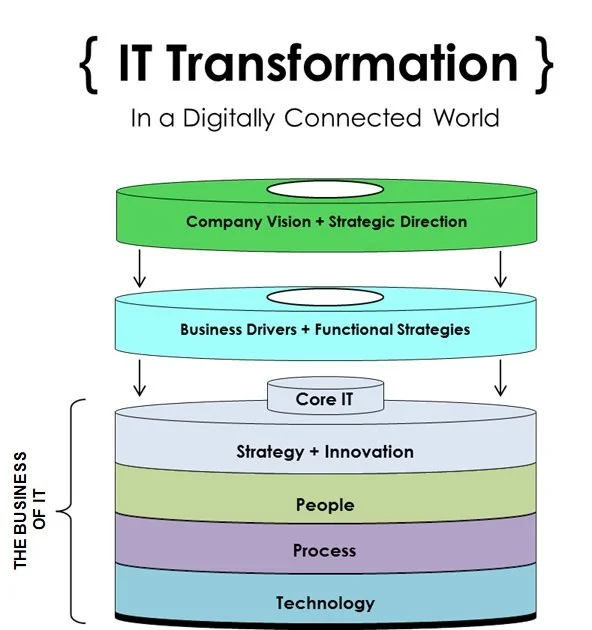In today's dynamic business landscape, organizations are continually seeking ways to harness the power of technology to drive growth, enhance efficiency, and stay competitive. Amidst this pursuit, an effective IT transformation model emerges as a guiding beacon, illuminating the path towards digital evolution and organizational success. Let's delve into a holistic approach, comprising distinct building blocks, to orchestrate a seamless IT transformation journey.
1. Company Vision + Strategic Direction: At the heart of any IT transformation initiative lies alignment with the overarching company vision and strategic direction. This foundational block sets the course for IT endeavors, ensuring that technological advancements are seamlessly integrated into the fabric of the organization's goals and aspirations. Clear articulation of the company's long-term vision enables IT leaders to chart a roadmap that not only addresses current challenges but also anticipates future opportunities.
2. Business Drivers + Functional Strategies: Understanding the underlying business drivers is paramount in shaping IT transformation strategies. Whether it's enhancing customer experience, optimizing operational efficiency, or fostering innovation, IT initiatives must directly correlate with these overarching objectives. By closely aligning functional strategies with business imperatives, organizations can prioritize investments, allocate resources judiciously, and derive maximum value from their IT endeavors.
3. The Business of IT (Strategy + Innovation), People, Process, Technology: A multifaceted approach encompassing the business of IT is pivotal for driving meaningful transformation. Firstly, strategic IT planning, coupled with a culture of innovation, lays the groundwork for leveraging technology as a strategic asset rather than a mere operational necessity. Secondly, investing in people, nurturing talent, and fostering a culture of continuous learning and development are indispensable elements in building a resilient and adaptive IT workforce. Thirdly, optimizing processes and workflows ensures operational efficiency, agility, and responsiveness, thereby enhancing overall organizational performance. Finally, technology serves as the cornerstone, encompassing infrastructure, applications, platforms, and emerging digital solutions, all orchestrated to support and propel business objectives forward.
4. Core Elements of IT: Within the realm of IT, several core elements underpin successful transformation endeavors. These include robust cybersecurity measures to safeguard digital assets and customer trust, data analytics capabilities to derive actionable insights and drive informed decision-making, cloud computing for scalability, flexibility, and cost-efficiency, and modernization of legacy systems to ensure relevance and agility in a rapidly evolving technological landscape.
In essence, an effective IT transformation model intertwines these building blocks into a cohesive framework, driving alignment, synergy, and agility across the organization. By embracing this holistic approach, businesses can unlock their full potential, harness the transformative power of technology, and embark on a journey of sustainable growth and innovation.

